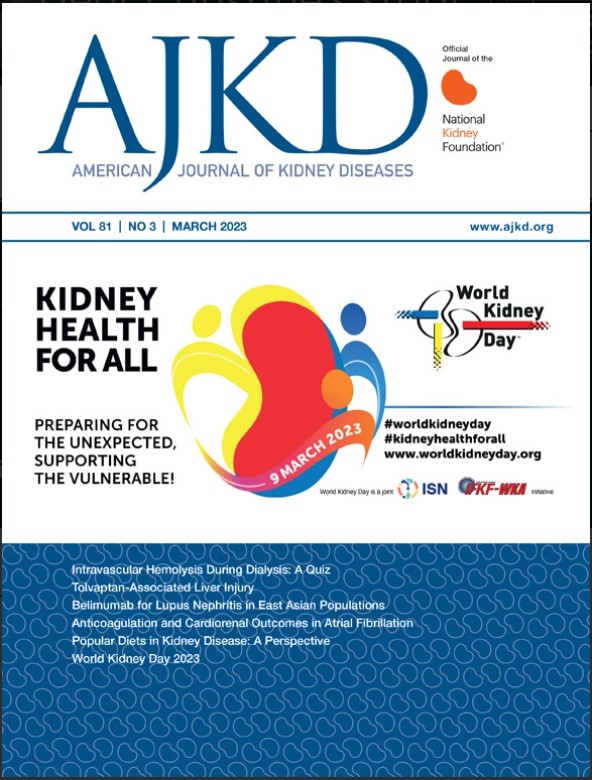Carbon Emissions From Different Dialysis Modalities: A Life Cycle Assessment
IF 8.2
1区 医学
Q1 UROLOGY & NEPHROLOGY
引用次数: 0
Abstract
Rationale & Objective
As the health impacts of climate change intensify, the health care sector faces growing pressure to minimize its carbon footprint. Achieving this goal requires understanding of the carbon impact of widely used medical treatments. This study evaluated and compared the carbon footprints of in-center hemodialysis, home hemodialysis, automated peritoneal dialysis (APD), and continuous ambulatory peritoneal dialysis (CAPD).
Study Design
Comparative life cycle assessment.
Setting & Participants
In-center hemodialysis, home-based hemodialysis, CAPD, and APD treatments provided by the Royal Melbourne Hospital Kidney Care Service, Melbourne, Victoria, Australia.
Outcome
Carbon emissions in kilograms of carbon dioxide equivalents (kg CO2e) from the annual provision of dialysis to a single patient.
Analytical Approach
Attributional process-based comparative life cycle assessment methodology was used to identify the sources and extent of carbon emissions for all dialysis modalities.
Results
In-center hemodialysis had the highest annual per patient carbon impact, at 4,814 kg CO2e. In comparison, emissions from home hemodialysis were 41% lower (2,938 kg CO2e), APD 29% lower (3,339 kg CO2e), and CAPD 59% lower (1,969 kg CO2e). Across all 4 modalities, consumables were the largest source of emissions. For in-center hemodialysis, patient travel was the main factor contributing to its higher carbon footprint compared with home-based dialysis options.
Limitations
Single dialysis provider in an urban setting.
Conclusions
In-center hemodialysis has a substantially higher carbon footprint than all home dialysis options, informing the choice of home dialysis when feasible and appropriate for individual patients.
Plain-Language Summary
As climate change intensifies, there is growing pressure on health care systems to reduce their greenhouse gas emissions. To do this effectively, it is important to understand the carbon footprint of different treatment options and identify key areas where emissions are highest. This study compared greenhouse gas emissions from 4 types of dialysis: hemodialysis performed in a health care facility (in-center hemodialysis), home hemodialysis, automated peritoneal dialysis (APD), and continuous ambulatory peritoneal dialysis (CAPD). We found that in-center hemodialysis had the highest carbon footprint, primarily due to the impact of patient travel. Among the home therapies, APD was responsible for higher emissions than home hemodialysis while CAPD had the lowest carbon footprint. Across all treatment types, consumables were the largest source of carbon emissions.
不同透析方式的碳排放:生命周期评估。
理由与目的随着气候变化对健康的影响加剧,医疗保健部门面临着越来越大的压力,以尽量减少其碳足迹。实现这一目标需要了解广泛使用的医疗方法对碳的影响。本研究旨在评估和比较中心血液透析、家庭血液透析、自动腹膜透析(APD)和持续动态腹膜透析(CAPD)的碳足迹。研究设计:比较生命周期评价。中心血液透析、家庭血液透析、CAPD和APD治疗由澳大利亚维多利亚州墨尔本皇家墨尔本医院肾脏护理服务中心提供。结果:每年向一名患者提供透析所产生的碳排放量,单位为千克二氧化碳当量(kg CO2e)。分析方法基于归因过程的比较生命周期评估方法用于确定所有透析方式的碳排放来源和程度。结果中心血液透析患者年人均碳影响最高,为4,814 kg CO2e。相比之下,家庭血液透析的排放量降低了41% (2,938 kg CO2e), APD降低了29% (3,339 kg CO2e), CAPD降低了59% (1,969 kg CO2e)。在所有四种模式中,消耗品是最大的排放源。对于中心血液透析,与家庭透析相比,患者旅行是导致其碳足迹更高的主要因素。局限性:城市单一透析提供者。结论:中心血液透析的碳足迹明显高于所有家庭透析选择,提示在可行且适合个体患者的情况下选择家庭透析。
本文章由计算机程序翻译,如有差异,请以英文原文为准。
求助全文
约1分钟内获得全文
求助全文
来源期刊

American Journal of Kidney Diseases
医学-泌尿学与肾脏学
CiteScore
20.40
自引率
2.30%
发文量
732
审稿时长
3-8 weeks
期刊介绍:
The American Journal of Kidney Diseases (AJKD), the National Kidney Foundation's official journal, is globally recognized for its leadership in clinical nephrology content. Monthly, AJKD publishes original investigations on kidney diseases, hypertension, dialysis therapies, and kidney transplantation. Rigorous peer-review, statistical scrutiny, and a structured format characterize the publication process. Each issue includes case reports unveiling new diseases and potential therapeutic strategies.
 求助内容:
求助内容: 应助结果提醒方式:
应助结果提醒方式:


